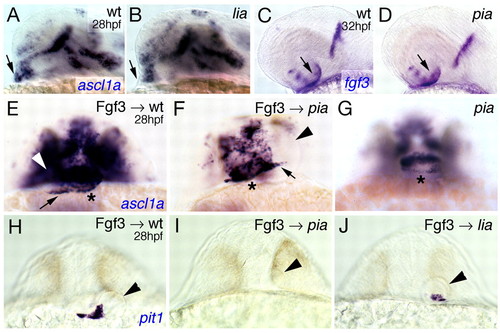|
Fgf3 is required for adenohypophyseal ascl1a expression and requires Ascl1a to induce pit1 expression. (A-D) Whole-mount in situ hybridization (lateral views with anterior towards the right) showing that adenohypophyseal ascl1 expression (indicated by arrows in A,B) is lacking in fgf3/lia mutants at 28 hpf, while diencephalic fgf3 expression (indicated by arrows in C,D) is normal in ascl1a/pia mutants at 32 hpf. (E-J) Frontal views on embryos at 28 hpf, after implantation of Fgf3-soaked beads in embryos of indicated genotype, and in situ hybridization for ascl1a (E-G) or pit1 (H-J). Beads in E,F,H-J are marked with arrowheads. Arrows in E,F mark laterally expanded ascl1a expression; asterisks in E-G indicate medial adenohypophyseal ascl1a expression, which is much stronger in the pia mutant after Fgf3 bead implantation (F) compared with untreated pia sibling (G).
|

